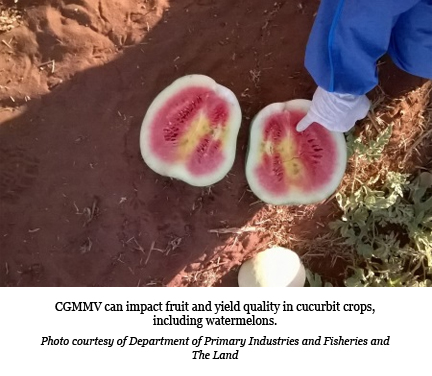by Lendon Keane, The Land
An Israeli plant pathologist who has been flown in to assist the Department of Primary Industry and Fisheries combat cucumber green mottle mosaic virus says Northern Territory watermelon growers are in a “good situation” to win the war that has crippled the $60 million industry.
 The virus was initially detected in a commercial watermelon crop near Katherine in September and, in total, 10 properties – including eight in the Katherine region – have been quarantined and slapped with a two-year growing ban after returning positive test results.
The virus was initially detected in a commercial watermelon crop near Katherine in September and, in total, 10 properties – including eight in the Katherine region – have been quarantined and slapped with a two-year growing ban after returning positive test results.
Impacted growers were forced to burn and bury their crops in a bid to stop the virus spreading to other NT growing areas and across borders.
Intensive testing for the virus has been carried out across Australia and Dr Aviv Dombrovsky, who was in Katherine on January 7 to take part in a workshop with growers, said he believed the fact there had been no additional outbreaks reported was a sign eradication was possible.
“If now, there are only 10 locations and you burn everything, and if still it didn’t spread to any other properties, it sounds possible to eradicate,” he told the Katherine Times.
“You are in a good situation now, if you combine [destroying infected crops and soil monitoring in quarantine areas] with the checking of the seeds that go into the country.”
CGMMV was detected in the wild, not a commercial crop, in Israel in 1991, meaning eradication was not a viable option.
Dr Dombrovsky said ongoing research and development over the past 24 years had allowed Israeli growers to reduce the impact of the virus, adding that the NT was in a “different status” because only commercial crops appear to have been infected.
“In Israel, the virus is spread all over the country … it’s impossible for us now to eradicate, so we are in a different status,” he explained.
NT chief plant health manager Stephen West said, while investigations continued, infected seed was the most probable cause of the outbreak.
“I think we’re really in a fortunate situation in that as we’ve identified seed is the principle mover, so obviously, it would seem that it’s come to the Territory in seed,” he said.
“So the fortunate part is that it would seem the small amount of seed that was infected has ended up here [and not in other parts of Australia as well].”
Mr West said the NT government had made Crown land in the Katherine region available for impacted growers to plant crops on during the quarantine period, but admitted the set-up costs involved with doing so – up to $500,000 – would make it commercially unviable for many.
“There has been an offer made around making some land available around Katherine to look at that option,” he said.
“The other option was about if somebody was able to lease some other land, that there would be assistance for them to transfer the water rights from their existing property to that property.
“I’d have to say that, at this point in time, no one has made the decision to actually take up that offer and I think part of that is because there is a considerable investment that somebody would need to make.”
Source: The Land
